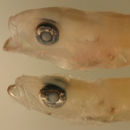en
names in breadcrumbs


Description: Body somewhat thin, long and narrow with a large eye and a terminal medium-sized mouth. Pectoral fins short, reaching only about halfway to vent. Pelvic fins short and clearly separate. Dorsal and anal-fin bases very short and the front and middle rays are longer than the back rays making a triangular outline to the fin, caudal peduncle relatively narrow and long and there are many procurrent caudal-fin rays in a distinct fleshy fold, from 11-14 in this larval type. Markings mostly along the ventral midline: melanophores usually as streaks (but often contracted and appear as spots) extending from the isthmus most of the way to the vent (about 10), ending at the swim bladder (which is the full thickness of the abdomen and provides a clear view of the retroperitoneum), most individuals have an additional midline melanophore on the promontory just forward of the vent. There is a row of five melanophores along the bases of the last seven or eight anal-fin rays (variably paired) and several more continuing mostly as a streak along the ventral peduncle ending at the start of the lower procurrent caudal-fin rays. There are melanophores on the membranes only between the first and third anal-fin elements. Melanophores are concentrated at the base of the lower caudal-fin segmented rays extending out along the length of the rays. Unlike pre-transitional larvae of the other regional larval eleotrids discussed, there are melanophores at the base of soem or all of the upper caudal-fin segmented rays as well. The caudal peduncle has deep internal melanophores around the point of flexion of the spine which can connect to the caudal-fin base melanophores. Head markings comprise melanophores at the angle of the jaw and along the lower jaw at the tip and below the dentary just to the side of the tip (no markings on the upper jaw). There is often an "eyebrow" membrane lined with melanophores overlying the dorsal aspect of the upper third of the eyeball. There is a melanophore overlying the cleithrum visible upon lifting the operculum (paired). Internal melanophores surround the saccule and are present along the dorsal surface of the swim bladder and paired around the gut near the vent. Some individuals show several of the ventral midline melanophores extending internally along the hemal spine in the body segments posterior to the the vent. Series of transitional larvae show development of the eye from a moderately narrowed vertical oval with a slight posterior-inferior extension of the iris to fully round.
Gobiomorus dormitor larva
Gobiomorus dormitor larvae
Gobiomorus dormitor larvae
Diagnosis: Modal fin-ray counts of D-VI,11 (or 10) A-10 Pect-16 or 17 indicate Gobiomorus dormitor or Erotelis smaragdus. These genera have overlapping fin-ray counts and, given the inconsistent ranges reported in the literature, these cannot be relied on to distinguish the taxa. Leptophilypnus fluviatilis, from Panama, overlaps the dorsal and anal-fin-ray counts (with 10/10), but has 18-19 pectoral-fin rays. Larvae and recruits of Erotelis smaragdus differ in having a small eye and a row of melanophores along the base of the anal-fin membranes. The larvae of the eastern Pacific sibling species, Gobiomorus maculatus, shares the melanophore pattern. G4a
Analogues: The eleotrid larvae share a long thin body with relatively short dorsal and anal-fin bases, numerous procurrent caudal-fin rays, and a long ventral midline streak from the isthmus to the mid-abdomen. Larval Gobiomorus dormitor are distinguished by a particularly large eye (as transition approaches), melanophores on the first anal-fin membrane only, and the early appearance of melanophores at the base of some of the upper caudal-fin rays. The latter develop only during transition in Eleotris.